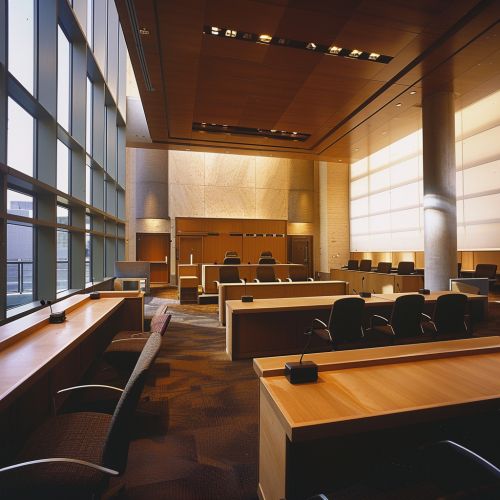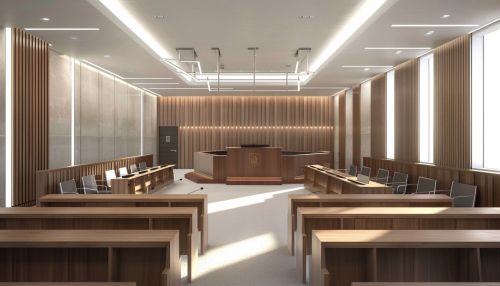Federal Rules of Civil Procedure: Difference between revisions
(Created page with "== Introduction == The Federal Rules of Civil Procedure (FRCP) are a comprehensive set of rules that govern civil litigation in the United States federal courts. Established to ensure consistent and fair procedures, the FRCP are critical for the administration of justice in civil cases. These rules cover a wide range of topics, including pleadings, motions, discovery, trials, and judgments. The FRCP are periodically amended to address evolving legal standards and practic...") |
No edit summary |
||
| Line 94: | Line 94: | ||
[[Category:Legal rules and regulations]] | [[Category:Legal rules and regulations]] | ||
[[Image:Detail-92917.jpg|thumb|center|A modern courtroom with a judge's bench, jury box, and counsel tables.|class=only_on_mobile]] | |||
[[Image:Detail-92918.jpg|thumb|center|A modern courtroom with a judge's bench, jury box, and counsel tables.|class=only_on_desktop]] | |||
Latest revision as of 19:55, 21 June 2024
Introduction
The Federal Rules of Civil Procedure (FRCP) are a comprehensive set of rules that govern civil litigation in the United States federal courts. Established to ensure consistent and fair procedures, the FRCP are critical for the administration of justice in civil cases. These rules cover a wide range of topics, including pleadings, motions, discovery, trials, and judgments. The FRCP are periodically amended to address evolving legal standards and practices.
Historical Background
The FRCP were first adopted in 1938, replacing the Conformity Act of 1872, which required federal courts to follow state procedural rules. The goal was to create a uniform set of procedures that would streamline litigation and reduce inconsistencies. The rules were developed by an advisory committee appointed by the Supreme Court of the United States, and they have been amended multiple times to reflect changes in the legal landscape.
Structure and Organization
The FRCP are divided into several titles, each addressing different aspects of civil litigation:
Title I: Scope of Rules; Form of Action
This title outlines the scope and purpose of the FRCP, emphasizing the need for just, speedy, and inexpensive resolution of civil actions. It also establishes the distinction between civil and criminal procedures.
Title II: Commencement of Action; Service of Process, Pleadings, Motions, and Orders
Title II details the procedures for initiating a civil action, including the requirements for serving process, filing pleadings, and making motions. It specifies the necessary contents of a complaint and the methods for serving documents on parties.
Title III: Pleadings and Motions
This title focuses on the rules governing pleadings, such as complaints, answers, and counterclaims. It also addresses motions, including motions to dismiss and motions for summary judgment.
Title IV: Parties
Title IV outlines the rules for joining parties in a lawsuit, including permissive and compulsory joinder, intervention, and interpleader. It also addresses issues related to class actions and the representation of parties.
Title V: Disclosures and Discovery
Title V governs the discovery process, including the mandatory disclosure of information, depositions, interrogatories, requests for production of documents, and requests for admissions. It aims to facilitate the exchange of information between parties and prevent surprises at trial.
Title VI: Trials
This title covers the procedures for conducting trials, including jury selection, the presentation of evidence, and the roles of judges and juries. It also addresses issues related to trial management and the conduct of parties and attorneys.
Title VII: Judgment
Title VII outlines the rules for entering and enforcing judgments, including default judgments, summary judgments, and judgments as a matter of law. It also addresses post-trial motions and the correction of errors.
Title VIII: Provisional and Final Remedies
This title addresses provisional remedies, such as preliminary injunctions and temporary restraining orders, as well as final remedies, including the enforcement of judgments and the awarding of costs and attorney's fees.
Title IX: Special Proceedings
Title IX covers special types of proceedings, such as actions involving the United States government, actions in rem, and actions involving multiple parties or claims.
Title X: District Courts and Clerks
This title outlines the administrative functions of district courts and clerks, including the maintenance of records, the issuance of process, and the management of court dockets.
Title XI: General Provisions
Title XI contains general provisions applicable to all civil actions, including rules for computing time, the use of forms, and the application of the FRCP to specific types of cases.
Key Concepts and Procedures
The FRCP introduce several key concepts and procedures that are essential for understanding civil litigation in federal courts:
Pleadings
Pleadings are formal written statements filed by parties in a lawsuit, outlining their claims and defenses. The primary pleadings include the complaint, the answer, and, in some cases, a reply. The complaint initiates the lawsuit by stating the plaintiff's allegations and the relief sought. The answer responds to the complaint, admitting or denying the allegations and asserting any defenses.
Motions
Motions are formal requests made to the court for specific actions or rulings. Common motions include motions to dismiss, which seek to terminate the case without a trial, and motions for summary judgment, which request a judgment based on the undisputed facts of the case. Motions are typically supported by written briefs and may be accompanied by affidavits or other evidence.
Discovery
Discovery is the process by which parties obtain information from each other to prepare for trial. The FRCP mandate several forms of discovery, including:
- **Depositions:** Oral examinations of witnesses under oath, conducted outside of court.
- **Interrogatories:** Written questions that must be answered under oath.
- **Requests for Production:** Demands for the production of documents or other tangible evidence.
- **Requests for Admissions:** Requests for the opposing party to admit or deny specific facts.
Summary Judgment
Summary judgment is a procedural device used to resolve a case without a trial when there are no genuine disputes of material fact. A party may move for summary judgment by demonstrating that the evidence, viewed in the light most favorable to the opposing party, shows that there is no genuine issue for trial and that the moving party is entitled to judgment as a matter of law.
Trial Procedures
The FRCP establish detailed procedures for conducting trials, including the selection of jurors, the presentation of evidence, and the roles of judges and juries. The rules also address issues related to trial management, such as the scheduling of trial dates and the conduct of parties and attorneys during trial.
Post-Trial Motions
After a trial, parties may file post-trial motions to challenge the verdict or seek other relief. Common post-trial motions include motions for a new trial, which argue that the trial was flawed due to errors or misconduct, and motions for judgment as a matter of law, which assert that the evidence presented at trial was insufficient to support the verdict.
Appeals
The FRCP provide the framework for appealing decisions from federal district courts to the United States Courts of Appeals. Parties may appeal final judgments, as well as certain interlocutory orders, by filing a notice of appeal and presenting arguments in appellate briefs.
Amendments and Revisions
The FRCP are periodically amended to address changes in legal standards, technological advancements, and evolving practices in civil litigation. Amendments are proposed by the Advisory Committee on Civil Rules, reviewed by the Judicial Conference of the United States, and approved by the Supreme Court. Significant amendments have included changes to discovery rules, the introduction of electronic discovery, and modifications to the rules governing class actions.
Impact and Criticisms
The FRCP have had a profound impact on civil litigation in the United States, promoting consistency and fairness in federal courts. However, they have also faced criticism for various reasons:
- **Complexity:** Some critics argue that the FRCP are overly complex and difficult for non-lawyers to navigate.
- **Cost:** The discovery process, in particular, can be expensive and time-consuming, leading to concerns about access to justice.
- **Delay:** Critics have also pointed to delays in the resolution of cases, partly due to the extensive procedural requirements.
Despite these criticisms, the FRCP remain a cornerstone of the American legal system, providing a structured framework for the resolution of civil disputes.
See Also
Categories


